1. Understanding the Complexity Behind Healthcare App Development Cost
You might wonder, “Just how complicated can these apps get?” The answer is: extremely. Healthcare applications tend to pack a high level of functionality under the hood. From secure patient data storage to real-time telemedicine consults, developers must juggle multiple moving parts while staying compliant with regulatory frameworks.
1.1 Why Complexity Matters
Building a simple step-counting fitness application is one thing. Handling live video calls, advanced diagnostic tools, and encrypted health record transfers is another beast altogether. And that is exactly why you might see a huge variation in the healthcare app development cost. Even adding functionalities such as AI-driven medical imaging analysis or real-time integration with wearable devices can significantly increase your digital health app budget.
Consider a telehealth application that integrates with a hospital’s EHR (Electronic Health Record) system. Because EHR systems can be massive and sometimes antiquated, developers often need additional integration layers to ensure data flows securely and accurately. These complexities add up, which is why the cost to build a healthcare platform can vary so wildly.
1.2 Breaking Down Costs for Different Levels of Complexity
To give you a clearer sense of what we mean, here’s a simplified data table showing a rough breakdown of features and corresponding budget ranges. [Please note: these numbers are illustrative and can vary based on your region and specific business requirements.]
| Complexity Level | Approximate Budget Range | Key Features |
|---|---|---|
| Basic | $15,000 – $50,000 | Simple fitness tracking, static data display |
| Moderate | $50,000 – $200,000 | Appointment scheduling, basic analytics, push alerts |
| High | $200,000 – $400,000 | EHR integration, AI diagnostics, advanced encryption |
| Very High | Above $400,000 | Blockchain security, full telemedicine suite, multi-AI modules |
Notice how quickly the budget scales. It’s not just about “adding one more feature.” Healthcare projects often break thresholds unexpectedly. Actually, that’s one reason strategic planning is invaluable, because it prevents you from encountering unpleasant sticker shocks.
2. Key Factors Influencing Healthcare App Costs
2.1 Data Security and Encryption
Security in the health sector is like the final mile in a marathon—it’s essential to cross that line cleanly. We’re dealing with sensitive information (patient records, lab results, and more). Any data breach isn’t just a PR nightmare; it can lead to massive legal consequences. Consequently, encryption protocols (AES256, SSL/TLS for data in transit, advanced tokenization, etc.) aren’t optional. They’re mandatory. This is why an app’s security framework can be a significant contributor to the overall healthcare app development cost.
And robust security measures don’t just stop with encryption. There’s also the matter of secure architecture design, routine code audits, and regular compliance reviews. Each step adds a new layer of complexity, thus bumping up the medical app pricing breakdown.
2.2 HIPAA and GDPR Compliance
If an application handles any personally identifiable information in the United States, it must adhere to HIPAA (Health Insurance Portability and Accountability Act). Across Europe and other jurisdictions that follow EU rules, GDPR (General Data Protection Regulation) compliance is mandatory. In practice, this means specialized legal and technical expertise is vital—especially if your app crosses borders.
HIPAA-compliant app development costs can incorporate everything from specialized testing environments to ongoing compliance audits. It’s not a one-and-done affair. App developers also need to incorporate HIPAA compliance training, ensure secure backup solutions, implement role-based access controls, and so forth. If your business scope is global, you might need to juggle multiple compliance frameworks simultaneously, which can put extra heft into the digital health app budget.
2.3 Features and Integrations
A robust healthcare application might integrate with:
- Telemedicine modules [for real-time video consultations and remote examinations].
- Wearable device sensors [to track vital signs or diabetic metrics in real time].
- AI-driven diagnostics [for automated image processing or symptom analysis].
- Pharmacy and lab networks [to streamline prescriptions and test results].
Every extra layer of complexity translates directly into higher resource allocation. For instance, imagine a scenario where you want to integrate Apple Health data plus a specialized wearable that tracks oxygen saturation levels. That’s an advanced, multi-layer integration that demands thorough testing and more specialized developer skill sets. And guess what? It’ll influence your cost to build a healthcare platform in a fairly dramatic way.
2.4 UI and UX Design
Healthcare apps aren’t exactly known for being “fun,” but that doesn’t mean they have to be dull. Patients and practitioners alike appreciate elegant, intuitive user interfaces. Designing an engaging user flow often calls for designers skilled in empathy-driven design, so the interface is approachable for elderly patients, busy doctors, and everyone in between.
But great design can be an unexpected cost driver. If your target audience spans various demographic groups (such as older adults with possible visual impairments or color-blindness), you need robust accessibility features. That can increase the healthcare app development cost, even though it’s absolutely worthwhile—not just ethically but in terms of broad market adoption.
2.5 Development Team Expertise
Sometimes, your secret weapon is the expertise of the developers and project managers you hire. Because healthcare is a highly specialized industry, your developers need a firm grasp of both technology and healthcare regulations. If you need specialized skill sets (AI specialists, data scientists, cybersecurity experts, or blockchain engineers), the rates can be higher. But you also get a more sophisticated end product.
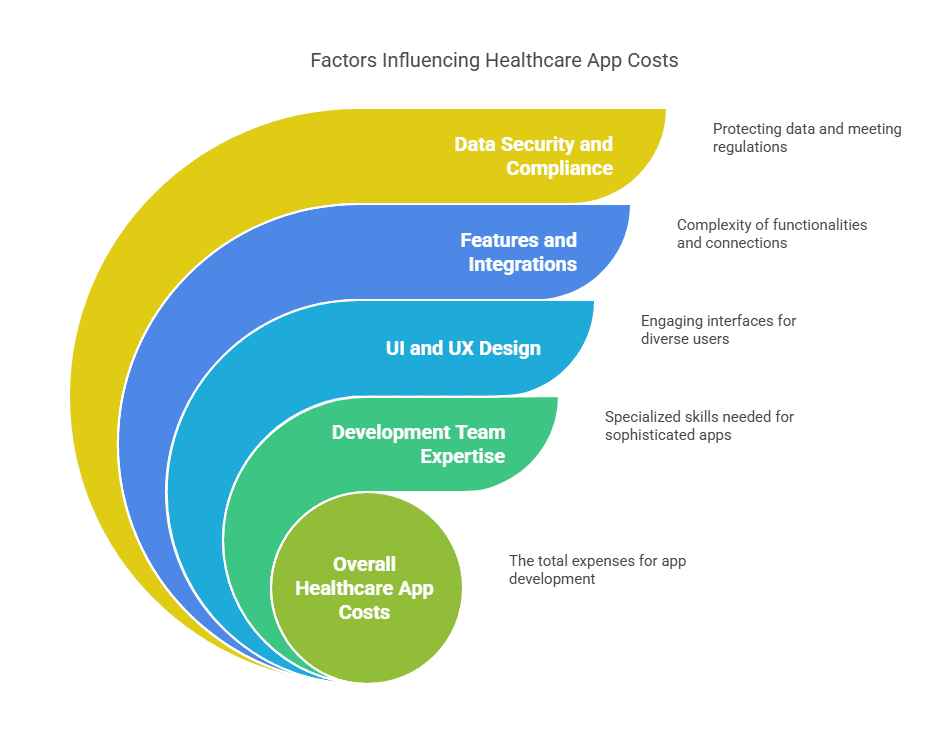
3. The Rise of Telemedicine [Why It Affects the Bottom Line]
Telemedicine has fast become more than just “nice to have.” In 2025, people fully expect to get a doctor’s check-up through a video call when they can’t make it into a clinic. As a result, standard healthcare apps are increasingly morphing into telehealth platforms. That shift means you need to factor in a telemedicine app cost estimate. Let’s talk about the specifics.
3.1 Real-Time Communication Infrastructure
Live video streaming, voice calls, and real-time messaging require robust backend architecture to handle data throughput. On top of that, encryption must also be real-time, which can demand specialized APIs or P2P encryption. These specialized requirements can drive up the digital health app budget, sometimes significantly. Every minute of glitch-free video chat with a physician is a direct reflection of the underlying infrastructure—engineered at a cost.
3.2 Scheduling and EHR Management
One of the biggest benefits of telemedicine is the ability to schedule virtual appointments and exchange health records instantly. However, setting up real-time scheduling that syncs with an EHR involves data flow from multiple systems. Because each EHR vendor might have a different data format or API, a good portion of your budget can go to integration tasks alone.
3.3 Additional Compliance Measures
Telemedicine extends the patient-doctor relationship beyond the walls of a clinic, which also extends HIPAA compliance to any environment that interacts with patient data. That often means your app will need disclaimers, secure login protocols, and rigorous data handling procedures. These intricacies raise HIPAA-compliant app development costs, but they also ensure patients and providers can trust your platform.

4. Harnessing AI Diagnostics [Opportunities and Additional Costs]
Artificial intelligence is no longer just an industry buzzword; it’s a transformative tool that can expedite medical decisions, detect anomalies in imaging, and even assist in triaging. Yet, adopting AI is neither simple nor cheap. It can place additional strain on your health tech app pricing guide because:
- Advanced Data Models: AI requires extensive datasets for training. Obtaining, cleaning, and labeling medical data is time-consuming and can sometimes mean partnering with data providers.
- Specialized Talent: Building AI modules often calls for data scientists or machine learning engineers. Their rates can be higher than what you’d pay for standard mobile app developers.
- Hardware: Training AI models sometimes requires GPU (Graphics Processing Unit)-enabled servers or even cloud-based machine learning platforms. That can be an ongoing operational cost.
- Testing & Validation: Because misdiagnosis or inaccuracy can have real-life health consequences, AI systems in healthcare undergo stricter testing protocols than in other sectors.
Taken together, these complexities expand what you might consider your cost to build a healthcare platform. But from a strategic perspective, many organizations find that these costs are balanced out by the efficiencies and market differentiators that advanced AI modules provide.
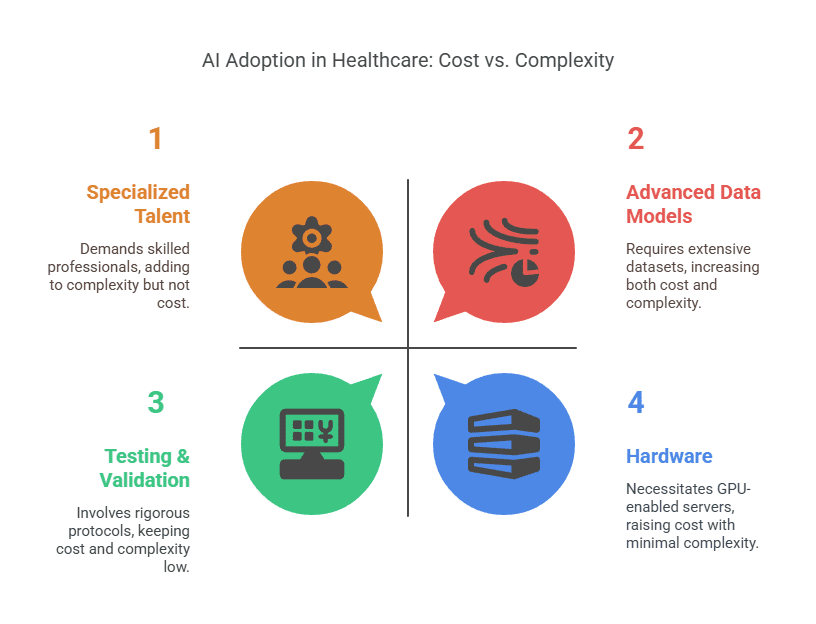
5. How Integrations With Wearables Influence Your Digital Health App Budget
Healthcare is moving toward prevention and real-time monitoring. Wearable devices (from Fitbit to specialized sensors for heart patients) can track steps, heart rate, and even glucose levels. Applications that integrate these data streams often stand out in the crowded health market. But of course, building that connectivity can create a ripple effect on your overall healthcare app development cost.
5.1 The Need for Stable APIs
Wearable devices typically require stable, well-documented APIs [Application Programming Interfaces]. Sure, many mainstream wearables like Apple Watch or Garmin trackers have thorough documentation, but custom medical-grade devices might not. The development team may have to build middleware or refine integration protocols. And if that wearable lacks standardized interoperability, your medical app pricing breakdown inevitably inched upward.
5.2 Real-Time Analytics
Sometimes it’s not enough just to show a user their heart rate data. You might want real-time actionable insights: automatic alerts for abnormal vitals or automated updates to a nurse’s dashboard. Achieving this requires additional layers of event-driven architecture and real-time data processing. This extra complexity feeds directly into your digital health app budget. But it also offers a distinct competitive advantage when done correctly.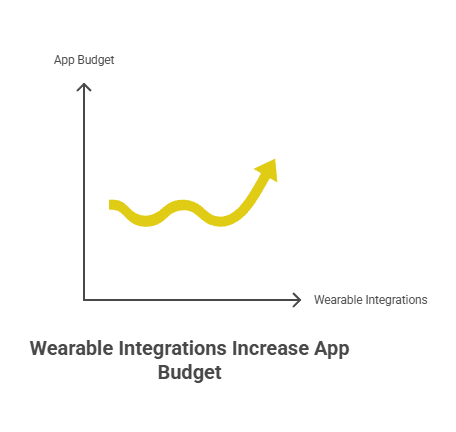
6. Steps to Control Healthcare App Development Cost
- Define a Minimum Viable Product (MVP): Start with the bare-bones, critical features. This approach ensures you can test your assumptions without overspending.
- Plan for Scalability: A well-structured architecture can scale more easily once you decide to add advanced features like AI diagnostics or telehealth modules.
- Leverage Existing Frameworks and APIs: Instead of reinventing the wheel, use existing libraries or platforms with proven track records for HIPAA-compliant solutions.
- Contract Specialized Teams: Partner with experts who understand the health sector. Their insights can actually save you money in the long run by avoiding pitfalls.
- Maintain Clear Documentation: Thorough documentation keeps everyone on the same page, preventing costly miscommunications and rework.
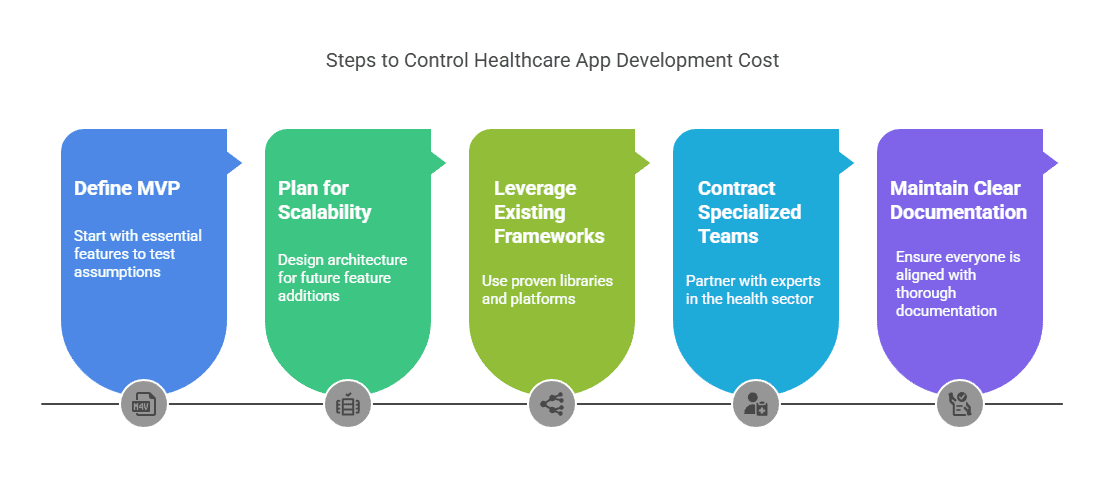
You might be tempted to cut corners, but the regulatory environment usually doesn’t allow that. Cutting corners in encryption or compliance is, to put it mildly, a bad idea. The answer is to plan methodically and pick battles wisely.
7. A Deeper Look at HIPAA-Compliant App Development Costs
We touched on HIPAA earlier, but it’s worth a deeper dig. Developing a HIPAA-compliant healthcare app involves more than ticking a few security checkboxes. You need to address privacy rules, set up secure (and audited) communication channels, and store data using robust encryption schemes. Additionally, staff training to ensure they know how to handle health data responsibly is essential.
Because HIPAA compliance is so rigorous, you’ll likely work with compliance consultants or at least an internal compliance officer. Their expertise can be pivotal when you’re interpreting the finer points of healthcare regulations. Yet every hour spent consulting on compliance is another hour added to your overall medical app pricing breakdown.
Yet, if done right, HIPAA compliance can turn into a selling point. Patients and medical partners will trust your platform more readily if they know you’ve gone the extra mile to secure their health data.
8. Implementation Challenges and Pitfalls
Here’s a thoughtful aside: sometimes the real challenge isn’t the coding. In my experience, the biggest implementation challenge can be bridging the gap between clinical workflows [how doctors and nurses actually work] and the new technology. If your team glosses over these day-to-day realities, your project might suffer from user adoption issues, forcing you to pump more money into redesign or re-training.
And let’s not forget about interoperability. Hospitals often run legacy systems that are decades old. Integrating your fancy new telehealth module with an outdated, on-premises EHR can be akin to forcing a square peg into a round hole. Projects like these run the risk of ballooning costs. Let me refine that statement: the hidden costs of integration can sometimes be even larger than the core application development budget if not managed carefully.
9. Additional Considerations for a Health Tech App Pricing Guide
When developing your health tech app pricing guide or forecast, it pays to look at hidden factors that aren’t always top-of-mind.
- Medical Device Classification: If your app integrates with FDA-regulated devices, be prepared for an extensive approval process.
- Liability Insurance: Some countries or regions may require specialized insurance.
- International Regulations: If you intend to deploy internationally, each region might have unique requirements, such as data localization or language support.
- Product Updates and Maintenance: Healthcare apps can’t stand still. You’ll likely face ongoing feature requests, security patch demands, and OS updates, which translate to a continuous slice of the budget.
Does this ring a bell? Many businesses jump into their projects only to discover that going global or working with specialized devices imposes more constraints than they initially expected.
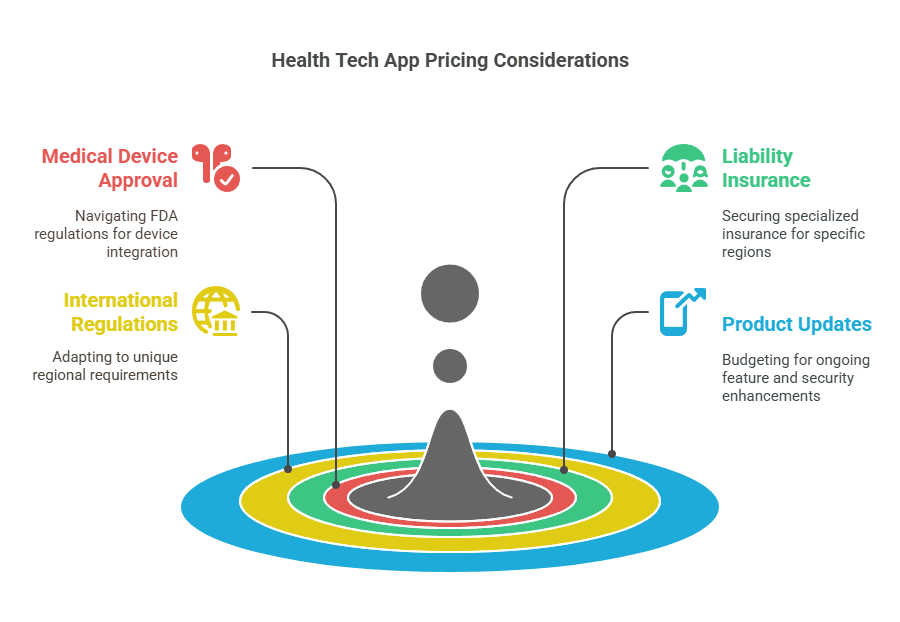
10. Building on Earlier Points: Cost Forecasting
We’ve already discussed how to plan for an MVP, but there’s also a need for accurate forecasting. Let’s build on that point with a new insight: consider parallel planning. Develop a budget not just for your immediate MVP but also for potential expansions. That might include separate budgets for:
- AI integration [once user adoption reaches a certain threshold].
- Launching in multiple states or countries [especially crucial for telemedicine app cost estimate discussions].
- Offering advanced analytics to doctors or insurers.
By having an expansion path mapped out, you preserve flexibility and mitigate risk.
11. Practical Tip: Pilot Programs
One practical tip gleaned from real-world experience is to start small with a pilot program. Rather than rolling out your full solution nationwide (or globally), you deploy to a limited user base or region to test performance, gather real feedback, and make sure compliance holds up under real conditions. This approach can lead to:
- Early detection of critical bugs or compliance oversights.
- Thoughtful allocation of resources (like servers and staff) based on initial user adoption rates.
- A more refined telemedicine app cost estimate for full-scale rollout.
Pilot programs act like a mini dress rehearsal, ensuring your final product hits the ground running once you’re ready to deploy it widely.
12. Frequently Encountered Misconceptions
“You might wonder, does adding AI instantly drive up user satisfaction?” The answer is: not always. Some organizations mistakenly believe that more features automatically translate to a better and more valuable product. In reality, too many bells and whistles can clutter the user experience. Instead, focus on the right features for your target audience and refine them like a craftsman polishing a gemstone.
Another misconception concerns compliance. Although HIPAA-compliant app development costs can be significant, some believe that crowding your solution with disclaimers or complex user flows is the only way to meet regulations. Overcomplicating your user interface in pursuit of compliance can make your app cumbersome. Ideally, you’ll find a healthy balance between compliance necessity and usability.
13. Medical App Pricing Breakdown [A Strategic Outline]
Let’s lay out a summary of how a basic pricing breakdown might look in a typical project timeline:
- Discovery and Requirement Analysis (2-4 weeks): Setting project goals, compliance requirements, and user flow. Cost range [5-10% of total budget].
- UI/UX Design (4-8 weeks): Wireframes, user testing, design refinements. Cost range [10-15% of total budget].
- MVP Development (8-16 weeks): Core features such as sign-up, basic telehealth modules, EHR integration. Cost range [40-50% of total budget].
- AI Integration (Optional, 6-12 weeks): Adding advanced diagnostics, real-time analytics. Cost range [10-20% of total budget].
- QA and Compliance Testing (4-8 weeks): Security checks, HIPAA validation, user acceptance testing. Cost range [10-15% of total budget].
- Release and Maintenance (Ongoing): Deployment, bug fixes, OS upgrades. Cost range [varies but typically 10-15% of total project budget per year].
Numbers here serve as a guide. Each project is unique. Yet, it gives you an overarching sense of the cost to build a healthcare platform.
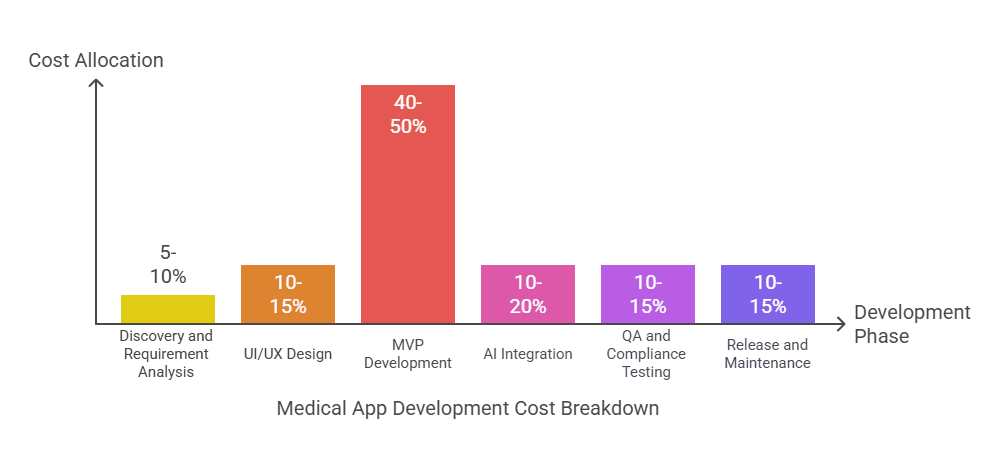
14. Conclusion: Formulating Your Digital Health App Budget
So, what’s the best way to navigate the winding path of healthcare app development cost? Start by carefully scoping the critical features [telemedicine, AI diagnostics, wearable integration, etc.]. Then align your budget with realistic benchmarks, factor in compliance from the earliest stages, and consider a pilot program to test the waters.
A well-designed healthcare application can be a game-changer by improving patient outcomes and streamlining clinical workflows. But it’s also a substantial investment. Whether you’re just aiming to produce a telemedicine app cost estimate or go for full-scale AI-driven solutions, it’s vital to know your constraints and plan accordingly. With the right team, robust security, and thorough compliance measures, your healthcare platform can be both effective and financially sensible.
Remember, success in this space doesn’t come from layering on every inch of technology; it’s about striking the right balance between user needs, design, compliance, and your digital health app budget. If you approach these aspects carefully, you’ll be well on your way to delivering a solution that patients, providers, and regulators can all embrace.







